Palm Springs Air Museum's Bell P-63A Kingcobra Airplane Video
More Bell P-63 Kingcobra Videos 1 2 - Bell P-63 Kingcobra Pictures
|
|
|
|
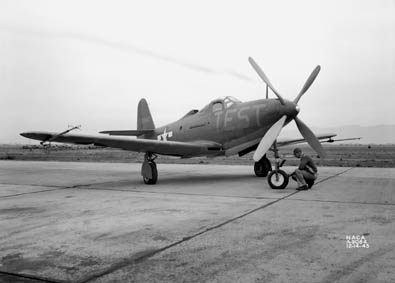 |
Crew: 1 |
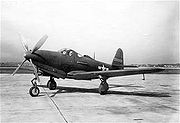 (Image: USAAF P-63A USAF photo)
(Image: USAAF P-63A USAF photo)
Role: Fighter
Manufacturer: Bell Aircraft Corporation
First flight: 7 December 1942
Introduced: October 1943
Status: retired
Primary users: United States Army Air Force, Soviet Air Force, French
Air Force
Produced: 1943–1945
Number built: 3,303
Unit cost: 65,914 USD in 1945
Developed from: P-39 Airacobra
The Bell P-63 Kingcobra (Model 24) was a United States fighter aircraft developed in World War II from the P-39 Airacobra in an attempt to correct that aircraft's deficiencies. Although the aircraft was not accepted for combat use by the USAAF, it was successfully adopted by the Soviet Air Force.
Design and development
XP-39E
While the P-39 had originally been introduced as an interceptor, later in its development it was decided to reduce the cost and complexity of the engine by removing the turbocharger and replacing it with a simpler mechanical supercharger. High-altitude performance suffered dramatically as a result, and Bell proposed an experimental series to test out a variety of solutions.
The resulting XP-39E featured two primary changes from the earlier P-39D from which it was developed. One change was the addition of a new laminar flow wing planform, which had recently been revealed to the industry through a National Advisory Committee for Aeronautics (NACA) research project. The other was a switch to the Continental I-1430 engine, which featured an improved overall design developed from the hyper engine efforts, as well as an improved supercharger.
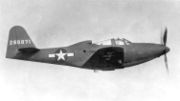 (Image: P-63A-1BE 42-68871)
(Image: P-63A-1BE 42-68871)
Three prototypes were ordered in April 1941 with serials 41-19501, 41-19502 and 42-7164. The V-1430 was having continued development problems and could not be delivered in time, so it was replaced by the newer -47 version of the Allison V-1710 that powered the basic P-39. Each of the prototypes tested different wing and tail configurations: 41-19501 had a rounded vertical tail, but the tailplane had squared-off tips, 41-19502 had a squared-off fin and rudder and large wing fillets while 42-7164 had all its flight surfaces squared off. The XP-39E proved to be faster than the standard Airacobra; a maximum speed of 386 mph (621 km/h) being attained at 21,680 ft (6,610 m) during tests. However, the XP-39E was considered to be inferior to the stock P-39 Airacobra in all other respects, so it was not ordered into production.
XP-63
Although the XP-39E proved to be disappointing, the USAAF was nevertheless interested in an even larger aircraft based on the same basic layout. Even before its first flight, the USAAF placed an order on 27 June 1941 for two prototypes of an enlarged version powered by the same V-1710-47 engine. The new design was given the designation XP-63 and serials were 41-19511 and 41-19512. A third prototype was also ordered, 42-78015, this one featuring the Packard V-1650, the U.S.-built version of the Rolls-Royce Merlin engine.
 (Image: P-63A-6BE 42-68931 on skis)
(Image: P-63A-6BE 42-68931 on skis)
The XP-87897 was larger in all dimensions than the Airacobra. The laminar flow wings increased the overall span by 4.33 feet (1.32 m) to 38.33 feet (11.68 m). The engine was fitted with a second supercharger supplementing the normal single-stage supercharger. At higher altitudes when additional boost was required, a hydraulic clutch would engage the second supercharger, adding 10,000 feet (3,000 m) to the service ceiling. A larger four-bladed propeller was also standardized. A persistent complaint against the Airacobra was that its nose armament was not easily accessible for ground maintenance, and in order to cure this problem, the XP-63 airframe was fitted with larger cowling panels.
In September 1942, even before the prototype flew, the USAAF ordered it into production as the P-63A (Model 33). The P-63A's armament was to be the same as that of the then-current P-39Q, a single 37 mm cannon firing 120 rpm through the propeller hub, two .50 caliber machine guns in the upper nose firing 300 rpm each through the prop, and two .50 caliber machine guns in underwing gondolas at a rate of around 780 rpm each, for a total of 2280 rpm. The trajectory of the .50s was far flatter than the cannon. Much later, in Soviet service, the unreliable Olds 37 mm was often replaced with the new Berezin B-20 cannon; the twin .50s replaced with UBS 12.7 mm in the nose only, for a rate of fire on the order of 2400 rpm with similar trajectories.
 (Image: P-63C-5BE 44-4417 with underwing pods)
(Image: P-63C-5BE 44-4417 with underwing pods)
The first prototype, 41-19511, flew for the first time on 7 December 1942, the first anniversary of Pearl Harbor. It was destroyed on 28 January 1943 when its landing gear failed to extend. The second prototype, 41-19512, followed 5 February 1943. It too was destroyed, this time due to an engine failure. The Merlin-engined 42-78015 was later delivered with another Allison instead, as the Merlins were primarily needed for the P-51 Mustang. Nevertheless the new -93 version of the Allison had a war emergency rating of 1,500 hp (1,100 kW) at sea level, making this prototype one of the fastest Kingcobras built, attaining 421 mph (678 km/h) at 24,100 feet (7,300 m).
Deliveries of production P-63As began in October 1943. The USAAF concluded the Kingcobra was inferior to the Mustang, and declined to order larger quantities. American allies, particularly the Soviet Union, had a great need for fighter aircraft, however, and the Soviets were already the largest users of the Airacobra. Therefore, the Kingcobra was ordered into production to be delivered under Lend-Lease. The Soviet Government sent a highly experienced test pilot, Andrey G. Kochetkov, and an aviation engineer, Fiodor Suprun, to the Bell factories to participate in the development of the first production variant, the P-63A. Initially ignored by Bell engineers, Kochetkov's expert testing of the machine's spin characteristics (which led to airframe buckling) eventually led to a significant Soviet role in the development. After flat spin recovery proved impossible, and upon Kochetkov's making a final recommendation that pilots should bail out upon entering such a spin, he received a commendation from the Irving Parachute Company.
P-63A-8, SN 269261, was extensively tested at TsAGI in the world's largest wind tunnel at the time. Soviet input in the development was significant. With the USSR being the largest buyer of the aircraft, Bell was quick to implement their suggestions. The vast majority of the changes in the A sub-variants were a direct result of Soviet input, e.g. increased pilot armor and fuselage hardpoint on the A-5, underwing hardpoints and extra fuel tanks on the A-6, etc. The Soviet Union even experimented with ski landing gear for the P-63A-6, but this never reached production. Most significantly, Soviet input resulted in moving the main cannon forward, favorably changing the center of gravity, and increasing its ammo load from 30 to 58 shells for the A-9 variant. The P-63 had an impressive roll rate, besting the P-47, P-40, N1K2 and P-51 with a rate of 110° per second at 275 mph.
Operational service
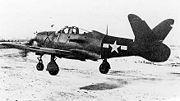 (Image: P-63G-1BE 45-57300 with V-tail)
(Image: P-63G-1BE 45-57300 with V-tail)
Air Transport Command ferry pilots, including U.S. women pilots of the WASP program, picked up the planes at the Bell factory at Niagara Falls, New York, and flew them to Great Falls, Montana and then onward via the Alaska-Siberia Route (ALSIB), through Canada, over Alaska where Russian ferry pilots, many of them women, would take delivery of the aircraft at Nome and fly them to the Soviet Union over the Bering Strait. A total of 2,397 such aircraft were delivered, out of the overall 3,303 production aircraft (72.6%).
By a 1943 agreement, P-63s were disallowed for Soviet use against Germany and were supposed to be concentrated in the Soviet Far East for an eventual attack on Japan. However, there are many unconfirmed reports from both the Soviet and German side that P-63s did indeed see service against the Luftwaffe. Most notably, one of Pokryshkin's pilots reports in his memoirs published in the 1990s that the entire 4th GvIAP was secretly converted to P-63s in 1944, while officially still flying P-39s. One account states they were in action at Königsberg, in Poland and in the final assault on Berlin. There are German reports of P-63s shot down by both fighters and flak. Nevertheless, all Soviet records show nothing but P-39s used against Germany.
In general, official Soviet histories played down the role of Lend-Lease supplied aircraft in favor of local designs, but it is known that the P-63 was a successful ground attack aircraft in Soviet service. The Soviets developed successful group aerial fighting tactics for the Bell fighters and P-39s scored a surprising number of aerial victories over German aircraft, mostly Stukas and bombers but including many advanced fighters as well. Low ceilings, short missions, good radios, a sealed and warm cockpit and ruggedness contributed to their effectiveness. To pilots who had once flown the tricky Polikarpov I-16, the aerodynamic quirks of the mid-engined aircraft were unimportant. In the Far East, P-63 and P-39 aircraft were used in the Soviet invasion of Manchukoku and northern Korea, where a Soviet P-63A downed a Japanese fighter aircraft, an Army Nakajima fighter, Ki-43, Ki-44 or Ki-84, off the coast of North Korea. Sufficient aircraft continued in use after the war for them to be given the NATO reporting name of Fred. Some American pilots also reported seeing P-63s in service with North Korea during the Korean War.
In 1945, 114 later models were delivered to the French Armée de l'Air, but they arrived too late to see service in World War II. They however saw service during the First Indochina War before being replaced in 1951.
"Pinball" operations
Its main use in American service was the unusual one of a manned flying target for gunnery practice. The aircraft was generally painted bright orange to increase its visibility. All armament and the regular armor was removed from these RP-63 aircraft, and over a ton of armored sheet metal was applied to the aircraft. This was fitted with sensors that would detect hits, and these hits were signaled by illuminating a light in the propeller hub where the cannon would have been. This earned the aircraft the unofficial nickname of Pinball. Special frangible rounds made of a lead/graphite combination were developed that would disintegrate upon impact.
Variants
XP-63
Prototypes (two) (company designation was Model 24); USAAF serials (41-19511 and 41-19512).
XP-63A
Following the loss of the first two prototypes, an additional test aircraft was procured, USAAF serial 42-78015, originally ordered as a testbed for the proposed Rolls-Royce Merlin-poweredP-63B.
P-63A
The production model Bell Model 33; 1725 P-63As produced in various sub-marks.
P-63B
Proposed Rolls-Royce Merlin-poweredP-63B series was cancelled due to lack of availability of Merlin engines.
P-63C
Second production series differed from the P-63A by being powered by the uprated Allison V-1710-117 engine with a war emergency rating of 1,500 hp (1,100 kW) at sea level and 1,800 hp (1,300 kW) with water injection. The wingspan was reduced by ten inches. A total production run of 1,777 was completed.
P-63D
One aircraft (43-11718) powered by an Allison V-1710-109 (E22) 1,425 hp featured 0.83-foot (0.25 m) wingspan increase (to 39.17 feet), gross area being increased to 255 sq ft (23.7 m2) and, most noticeably, a rearward-sliding bubble canopy. The series was cancelled in 1945.
P-63E
Essentially similar to the P-63D with the exception of a ventral fin extension and the use of a standard "cab"-style cockpit; only 13 built.
P-63F
Bell Model 43 variant featured an enlarged vertical tail and Allison V-1710-135; only two (43-11719 and 43-11722) built.
RP-63A/C "Pinball"
Target aircraft with five modified from P-63As and 95 modified on production lines; in 1948, surviving RP-63A aircraft were redesignated QF-63A. A further 200 production RP-63C aircraft were modified on the production line. Similarly, the surviving RP-63Cs were redesignated RP-63Cs. Many of the "target" aircraft were actually used as target tugs.
RP-63G "Pinball"
"Dedicated" flying targets which included two prototypes (43-11723 and 11724) and 30 production aircraft that incorporated a flush dorsal inlet but, more significantly, lights that would come on when the target was struck with frangible munitions. In 1948, the remaining RP-63Gs were redesignated QF-63Gs.
Swept-wing L-39
 (Image: L-39 with swept wings, extended rear fuselage, ventral tail
fin and P-39 prop)
(Image: L-39 with swept wings, extended rear fuselage, ventral tail
fin and P-39 prop)
Two war surplus P-63Cs were modified by Bell under Navy contract for flight testing of low-speed and stall characteristics of high-speed wing designs. The aircraft received new wings with adjustable leading edge slats, trailing edge flaps and a pronounced sweep of 35 degrees. The wings had no wheel wells; only the nose gear was retractable. L-39-1 first flew 23 April 1946, demonstrating a need for extra tail surface and rear fuselage length to balance the aircraft in flight - the wing repositioning reduced empennage effectiveness and moved the center of lift aft. A lighter three-bladed propeller from a P-39Q-10 was mounted and the necessary changes to the empennage were made. L-39-2 incorporated these adjustments from the start.
 (Image: L-39-2 with swept wings and four-bladed prop)
(Image: L-39-2 with swept wings and four-bladed prop)
L-39-1 later went to NACA at Langley for wind tunnel testing, where much valuable data were gathered. L-39-2 also served as a testbed for the Bell X-2 40-degree wing design
Post war air racers
Numerous surplus P-63s ended up on the air racing circuit in the immediate postwar era.
Charles Tucker purchased two P-63s from the disposal facility at Kingman, Arizona just after the war. He entered one of them, the Tucker Special as Race 28 with the name Flying Red Horse emblazoned on the nose (civilian register N62995) in the 1946 Thompson Trophy race. He had clipped the wing in an attempt to improve its speed, reducing the span to 25 ft, 9 inches. The second one (44-4126 (XN63231) was intended for the 1946 Bendix cross country race. It was initially fitted with two wingtip drop tanks. In 1947, the drop tanks were removed and the wings were clipped to 28 ft 6 in (8.7 m)
Two other significant racers were flown later. Tipsy Miss, John Sandberg's clipped-wingtip P-63 unlimited racer, was identified as "Race 28," and painted in bright orange, white and black race numbers with a chrome spinner. Later sold to a European pilot, this P-63 was destroyed in an accident in 1990. Crazy Horse Campgrounds was the most radically modified P-63 Kingcobra ever. Larry Haven's "Race 90" clipped-wing unlimited racer had a tiny bubble canopy installed; it appeared in all silver (unpolished aluminum) finish with a white rudder and black trim. The aircraft later crashed into the ocean on a test flight in 1972.
Survivors
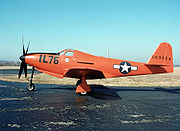 (Image: P-63E-1BE 43-11728 "Pinball" of the Air Force Museum)
(Image: P-63E-1BE 43-11728 "Pinball" of the Air Force Museum)
Several P-63s are on display in museums around the world. A handful are still flown as warbirds.
One RP-63G "Pinball" is currently at the National Museum of the United States Air Force near Dayton, Ohio. The aircraft is displayed in the museum's WWII hangar in its authentic bright orange paint scheme.
Specifications (P-63A Kingcobra)
General characteristics
-Crew: 1
-Length: 32 ft 8 in (10.0 m)
-Wingspan: 38 ft 4 in (11.7 m)
-Height: 12 ft 7 in (3.8 m)
-Wing area: 248 sq ft (23 m²)
-Empty weight: 6,800 lb (3,100 kg)
- Loaded weight: 8,800 lb (4,000 kg)
-Max takeoff weight: 10,700 lb (4,900 kg)
-Powerplant: 1 x Allison V-1710-117 liquid-cooled V-12, 1,800 hp (1,340 kW)
Performance
-Maximum speed: 410 mph (660 km/h) at 25,000 ft (7,620 m)
-Range:
-Combat: 450 mi (725 km)
-Ferry: 2,200 mi (3,500 km) (3,540 km)
-Service ceiling 43,000 ft (13,100 m)
-Rate of climb: 2,500 ft/min (12.7 m/s)
-Wing loading: 35.48 lb/sq ft (173.91 kg/m²)
-Power/mass: 0.20 hp/lb (0.34 kW/kg)
Armament
-1× 37 mm M4 cannon firing through the propeller hub
-4× 0.50 in (12.7mm) M2 Browning machine guns (two in the nose, two in the wings)
-1,500 lb (680 kg) bomb load on wing and fuselage
Page best for: bell p 63 kingcobra, p 63 kingcobra, bell p 63
Source: WikiPedia